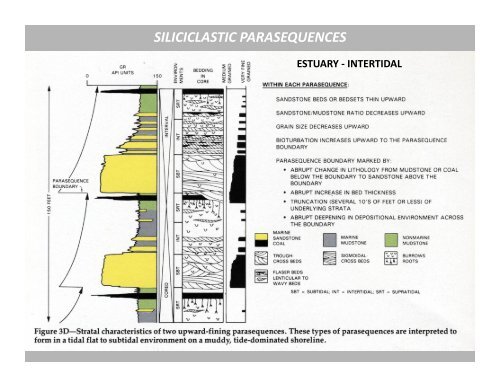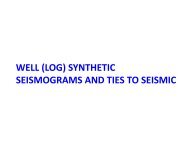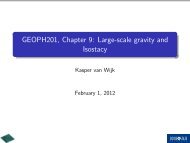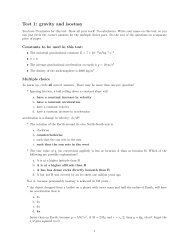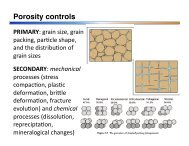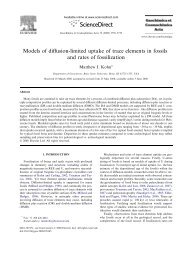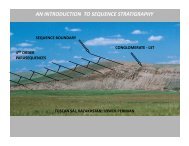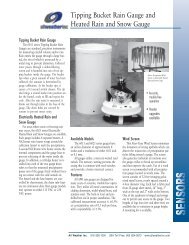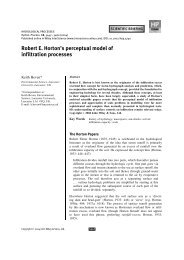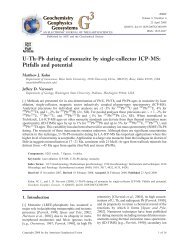Introduction to Sequence Stratigraphy
Introduction to Sequence Stratigraphy
Introduction to Sequence Stratigraphy
You also want an ePaper? Increase the reach of your titles
YUMPU automatically turns print PDFs into web optimized ePapers that Google loves.
SILICICLASTIC PARASEQUENCES ESTUARY -‐ INTERTIDAL
SILICICLASTIC PARASEQUENCES ESTUARY -‐ INTERTIDAL PARASEQUENCE
CARBONATE PARASEQUENCES
CARBONATE PARASEQUENCES
CARBONATE PARASEQUENCES
CARBONATE PARASEQUENCES
CARBONATE PARASEQUENCES
CARBONATE PARASEQUENCES
CARBONATE PARASEQUENCES
PARASEQUENCES STACKING AND SYSTEM TRACTS
PARASEQUENCE SETS PROGRADATIONAL PARASEQUENCE SET Rate of deposi,on Rate of Accommoda,on > 1 RETROGRADATIONAL PARASEQUENCE SET Rate of deposi,on Rate of Accommoda,on < 1 AGGRADATIONAL PARASEQUENCE SET Rate of deposi,on Rate of Accommoda,on = 1 (Van Wagoner et al, 1990, Fig. 10)
SEQUENCE STRAT BUILDING BLOCKS Parasequence sets: succession of “gene,cally related” parasequences that form “dis,nc,ve stacking paQerns; bounded, in many cases, by major marine-‐flooding surfaces and their correla,ve surfaces. Stacks of parasequences.
SEQUENCE STRAT BUILDING BLOCKS <strong>Sequence</strong> = conformable, gene,cally related succession of strata bounded by unconformi,es or their correla,ve conformi,es (Mitchum, 1977) A stack of parasequences / parasequence sets bounded by an unconformity (the sequence boundary) or its conformable equivalent (a plane of correla,on).
SYSTEM TRACTS
SYSTEMS TRACTS Ilustrated
SYSTEMS TRACTS Lowstand TYPE-‐I (Van Wagoner et al, 1990, Fig. 34)
SYSTEMS TRACTS Lowstand TYPE-‐I SEQUENCE BOUNDARY (Van Wagoner et al, 1990, Fig. 34)
SYSTEMS TRACTS Lowstand TYPE-‐I (Van Wagoner et al, 1990, Fig. 35)
(Van Wagoner et al, 1990, Fig. 36) SYSTEMS TRACTS Transgressive
(Van Wagoner et al, 1990, Fig. 37) SYSTEMS TRACTS Highstand
(Van Wagoner et al, 1990, Fig. 38) THE NEXT SEQUENCE Lowstand wedge turbidite ss & mudstn Submarine fan ss & cgl; base = seq bndry; overlies LSW
CARBONATE SEQUENCE STRATIGRAPHY 2 1 3 SEQ-‐24
SEQUENCE BOUNDARY TYPES SEQ-‐25
SEQUENCE BOUNDARY TYPES Type 1 sequence boundary (SB 1): for shelf-‐slope seZng where sea level drops below the shelf-slope break or for a ramp causes fluvial incision of a significant por]on of the ramp surface • Composed of lowstand, transgressive, and highstand systems tracts bounded beneath by type-‐1 unconformi,es and their correla,ve conformi,es. Type 2 sequence boundary (SB 2): for ramp margins without significant break in slope and where sea level does not drop below the shelf-‐slope break for shelf systems. • A more subtle shib in facies basinward above what would be considered a highstand systems tract. • Also results in unconformi,es with less amounts of erosion and less basinward shib in facies (i.e., can’t shove everything off the shelf). • Composed of shelf-‐margin, transgressive, and highstand systems tracts bounded beneath by type-‐2 unconformi,es and their correla,ve conformi,es. Can see these at the outcrop scale -‐ but best seen in seismic sec,on or when you have enough data <strong>to</strong> construct a detailed regional cross-‐sec,on. SEQ-‐26
TIME, UNCONFORMITIES & WEIRD TIME-‐CROSS SECTION DIAGRAMS LACUNA TIME SPACE
THE INCOMPLETE ROCK RECORD CONTACTS & BOUNDING SURFACES DIASTEMS Rela]vely short interrup]on in sedimenta]on; only brief interval of ]me with li^le or no erosion before deposi]on is resumed; most bedding planes are diastems.
THE INCOMPLETE ROCK RECORD CONTACTS & BOUNDING SURFACES WHAT ABOUT OTHER UNITS? Missing rock at these boundaries as well – missing record of ]me. SEQUENCE BOUNDARY (3 rd Order) 4 TH ORDER PARASEQUENCES CONGLOMERATE -‐ LST 5 TH Order 6 TH Order TUSCAN SAI, KAZAKHSTAN; LOWER PERMIAN
SEQUENCE BOUNDARY = UNCONFORMITY SHOREWARD BASINWARD LACUNA (missing interval strata) TIME UPPER SURFACE HIATUS (nondeposi]on interval) DEGRADATION VACUITY (eroded rock) CONTINUOUS DEPO (equivalent surface) ROCK THICKNESS DISTANCE
TIME SPACE IN SEQUENCE STRATIGRAPHY LACUNA TIME SPACE
TIME SPACE IN SEQUENCE STRATIGRAPHY TYPE 2 TYPE 1
CYCLE DRIVERS WHAT CAUSES THESE CYCLES? WHICH PROCESS ARE GLOBAL AND WHICH ARE REGIONAL/LOCAL? SEQUENCE BOUNDARY (3 rd Order) 4 TH ORDER PARASEQUENCES CONGLOMERATE -‐ LST 5 TH Order 6 TH Order TUSCAN SAI, KAZAKHSTAN; LOWER PERMIAN
MulVple physical & temporal scales = ? Several 100 m 1 cm 1 -‐4 m 10-‐100 m Several 100 <strong>to</strong> several 1,000 m 1-‐50 m
WHAT DRIVES THE CYCLES – SEQUENCE STRAT?
100,000 year glacial-‐eusta,c cycles determined from oxygen iso<strong>to</strong>pic data. CYCLE DRIVERS The High Frequency Signal
CYCLE DRIVERS The High Frequency Signal Milankovitch Theory
Milankovitch Theory Eccentricity: 100 kyr (blue) & 400 kyr (red) Obliquity / Tilt 41 kyr Precession: 19-‐24 kyr (wobble) (wobble)
Milankovitch Theory -‐ Eccentricity 95, 125, 400 kyr
Milankovitch Theory -‐ Precession 19 & 23 kyr Center of the Earth
END


